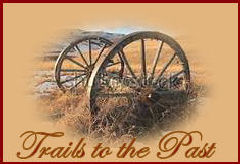|
Virginia City

 Peter O'Riley and Patrick McLaughlin
are credited with the discovery of the Comstock Lode.
Henry T. P. Comstock's name was associated with the
discovery through his own machinations. According to
folklore, James Fennimore, nicknamed Old Virginny
Finney, christened the town when he tripped and broke a
bottle of whiskey at a saloon entrance in the northern
section of Gold Hill, soon to become Virginia City. Peter O'Riley and Patrick McLaughlin
are credited with the discovery of the Comstock Lode.
Henry T. P. Comstock's name was associated with the
discovery through his own machinations. According to
folklore, James Fennimore, nicknamed Old Virginny
Finney, christened the town when he tripped and broke a
bottle of whiskey at a saloon entrance in the northern
section of Gold Hill, soon to become Virginia City.
In another story, the Ophir
Diggings were named in honor of Finney as he was "one of
the first discoverers of that mining locality, and one
of the most successful prospectors in that region."
Finney "was the best judge of placer ground in Gold
Canyon," locating the quartz footwall of the Ophir on 22
February 1858, the placers on Little Gold Hill on 28
January 1859, and the placers below Ophir in 1857.
After the discovery of the
Comstock Lode in 1859, the town developed seemingly
overnight on the eastern slopes of Mount Davidson,
perched at a 6200-foot elevation. Below the town were
dug intricate tunnels and shafts for silver mining. The
Comstock Lode discovery and subsequent growth of
Virginia City was unequaled by the history of other
precious metal discoveries. By 1876 Nevada produced over
half of all the precious metals in the United States.
The Comstock produced silver and gold ore valued at
hundreds of thousands of dollars. The wealth supported
the Northern cause during the American Civil War and
flooded the world monetary markets, resulting in
economic changes.
Virginia City's silver ore
discoveries were not part of the California Gold Rush,
which occurred 10 years before. At the time of the
discovery of the Comstock Lode, silver was considered
the monetary equal of gold, and all production was
purchased by the federal government for use in coinage.
In 1873, silver was demonetized by the government, in
large part due to the flood of silver into international
markets from the silver mines of Virginia
City.
Technical problems plagued the early
mining efforts, requiring the development of new mining
technology to support the challenge. German engineer
Philip Deidesheimer created a timbering system for
mining tunnels called square sets, which enabled the
retrieval of huge amounts of silver ore in a safe
manner. Square set timbering, roots blowers, stamp
mills, the Washoe Pan milling process, Cornish pumps,
Burleigh machine drills, wire woven rope, miners' safety
cages and the safety clutch for those cages; even the
Sutro tunnel all had a place in supporting the
exploitation of the rich ore body. As technological
advancements, these were used many times over in later
mining applications. In 1876 one observer reported that
in Virginia City, "every activity has to do with the
mining, transportation, or reduction of silver ore, or
the melting and assaying of silver
bullion."
Like many cities and towns in
Nevada, Virginia City was a mining boomtown; it
developed virtually overnight as a result of miners
rushing to the Comstock Lode silver strike of 1859. But,
Virginia City far surpassed all others for its peak of
population, technological advancements developed there,
and for providing the population base upon which Nevada
qualified for statehood. The riches of the Comstock Lode
inspired men to hunt for silver mines throughout Nevada
and other parts of the American West.
Virginia City population
increased from 4,000 in 1862 to over 15,000 in 1863. It
fluctuated depending on mining output. US Census figures
do not reflect all of these frequent changes. The city
included gas and sewer lines, the one hundred room
International Hotel with elevator, three theatres, the
Maguire Opera House, four churches, and three daily
newspapers. Many of the homes and buildings were made of
brick.
With this center of wealth, many
important local politicians and businessmen came from
the mining camp. At its peak after the Big Bonanza of
1873 Virginia City had a population of over 25,000
residents and was called the richest city in America. In
1879, the mines began to play out and the population
fell to just under 11,000. Dominated by San Francisco
moneyed interests, Virginia City was heralded as the
sophisticated interior partner of San Francisco. "San
Francisco on the coast and Virginia City inland" became
the mantra of west coast Victorian entrepreneurs. Early
Virginia City settlers were in large part the backwash
from San Francisco and the California Gold Rush, ten
years before. Mine owners who made a killing in the
Comstock mines spent most of their wealth in San
Francisco.
A San Francisco stock market
existed for the exploitation of Comstock mining. The
Bank of California financed building the financial
district of San Francisco with money from the Comstock
mines. The influence of the Comstock lode rejuvenated
what was the ragged little town of 1860 San Francisco.
"Nearly all the profits of the Comstock were invested in
San Francisco real estate and in the erection of fine
buildings." Thus, Virginia City built San Francisco. The
Comstock's success, measured in values of the time
period, totaled "about $400 million." Mining and its
attraction of population was the economic factor that
caused the separation of Nevada territory from Utah, and
later justified and supported Nevada
statehood.
The mining industry dominated
Virginia City, making it an industrial center similar to
those of the east coast. But the city retained some of
its frontier flavor. The social history of the town has
emphasized the high number of immigrants among its
residents. Miners largely from Cornwall, England, where
tin mines had been developed based on hard rock
technology, flooded the Comstock. The new English
immigrants were one of the largest ethnic groups. Many
of the miners who came to the city were Cornish or
Irish. In 1870, Asians were 7.6% of the population,
primarily Chinese workers who settled in many western
towns after they had completed construction of the
transcontinental railroad. The Chinese filled niche
markets, such as laundry workers and cooks.
Through time, the numerous
independent Comstock mines became consolidated under
ownership of large monopolies. A group called the Bank
Crowd, dominated by William Sharon in Virginia City and
William Ralston in San Francisco, financed the mines and
mills of the Comstock until they had a virtual monopoly.
By manipulating stock through rumors and false reports
of mining wealth, some men made fortunes from the stocks
of Virginia City's mines. When it appeared the Comstock
Lode was finished, the city's population declined
sharply, with ten thousand leaving in 1864 and 1865. By
the late 1860s, a group of Irish investors threatened
the Bank Crowd's control. John Mackay and partner James
Fair began as common miners, working their way up to
management positions in the mines. By purchasing stock
in the mines, they realized financial independence.
Their partners Flood and O'Brien stayed in San Francisco
and speculated in stock. The Irish Big Four, as the men
were called, eventually controlled the Consolidated
Virginia mine where the Big Bonanza was discovered in
1873. The next few years were some of the most
profitable on the Comstock, as the Bank Crowd lost
control to the Irish Big Four. Population reached 25,000
in 1875.
Mining operations were hindered by
the extreme temperatures in the mines caused by natural
hot springs. In winter the miners would snowshoe to the
mines and then have to descend to work in high
temperatures. These harsh conditions contributed to a
low life expectancy, and earned miners the nickname of
Hot Water Plugs. Adolph Sutro built the Sutro Tunnel to
drain the hot spring waters to the valley below. But, by
the time it was completed in 1879, the mines had
substantially passed the intersection level, as their
tunnels had been dug ever deeper.
Great Fire of 1875
Between 1859 and 1875, Virginia City
had numerous serious fires. The October 26, 1875 fire,
dubbed the Great Fire, caused $12 million in damage.
"The spectacle beggars description; the world was on
fire...a square mile of roaring flames." When a church
caught fire, Mackay was heard to say, "Damn the church!
We can build another if we can keep the fire from going
down these shafts." Though the Con. Virginia and Ophir
hoisting works burned, the fire did not penetrate the
Con. Virginia shaft and only reached 400 feet into the
Ophir shaft. "Railroad car wheels were melted", "brick
buildings went down like paper boxes", and two thousand
were left homeless.
In ensuing months the city was
rebuilt. A majority of the area now designated as the
National Historic Landmark historic district dates to
this later time period. However, the bonanza period was
at an end by 1880
The information on Trails to
the Past © Copyright
may be used in personal family history research, with
source citation. The pages in entirety may not be
duplicated for publication in any fashion without the
permission of the owner. Commercial use of any material
on this site is not permitted. Please respect the wishes
of those who have contributed their time and efforts to
make this free site possible.~Thank
you!
|


